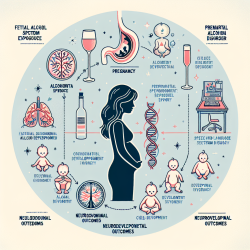Introduction
As practitioners in the field of speech-language pathology, it is crucial to base our interventions on solid research and data. The study "What proportion of the brain structural and functional abnormalities observed among children with fetal alcohol spectrum disorder is explained by their prenatal alcohol exposure and their other prenatal and postnatal risks?" provides valuable insights into the impact of prenatal alcohol exposure (PAE) on children's neurodevelopmental outcomes.
Key Findings
The research highlights that PAE is the dominant risk factor contributing to brain structural and functional abnormalities in children with Fetal Alcohol Spectrum Disorder (FASD). The study utilized a comprehensive neuropsychological battery and magnetic resonance imaging (MRI) to compare children with FASD to typically developing peers. The results showed that PAE explained the largest proportion of variance in brain outcomes, surpassing other prenatal and postnatal risk factors.
Implications for Practitioners
Understanding these findings can significantly enhance our practice:
- Early Identification: Recognizing the signs of FASD early can lead to timely interventions that mitigate the impact of PAE.
- Comprehensive Assessment: Incorporate a thorough evaluation of prenatal and postnatal risk factors during assessments to inform intervention strategies.
- Targeted Interventions: Focus on interventions that address both PAE and other contributing risk factors to optimize outcomes.
Encouraging Further Research
While this study provides significant insights, it also opens avenues for further research. Practitioners are encouraged to explore:
- The interaction between PAE and other risk factors in different populations.
- The long-term outcomes of interventions targeting multiple risk factors.
- Innovative assessment tools that can better capture the complexity of FASD.
Conclusion
By integrating the findings from this study into practice, we can enhance our ability to support children with FASD effectively. Continued research and data-driven approaches will further our understanding and improve intervention strategies.
To read the original research paper, please follow this link: What proportion of the brain structural and functional abnormalities observed among children with fetal alcohol spectrum disorder is explained by their prenatal alcohol exposure and their other prenatal and postnatal risks?










